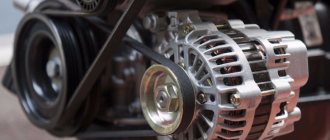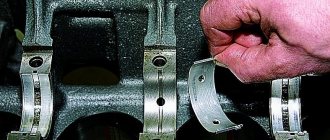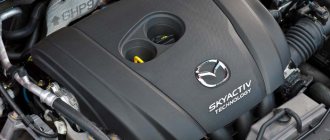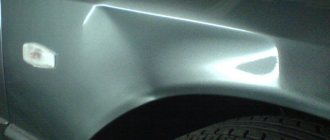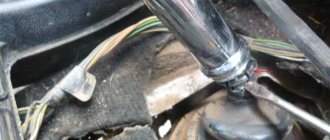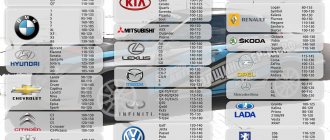Engine overhaul is a process during which the engine and the main components of the power system are brought to factory condition.
Engine overhaul involves disassembling and cleaning the engine, diagnosing components for defects and replacing them if necessary, repairing the crankshaft, cooling systems, lubrication and fuel supply, cylinder block and crank mechanism.
Overhaul and overhaul of the power unit are different procedures. By overhaul we mean disassembling and reassembling the engine and replacing failed elements. The reasons for a major overhaul are loss of power and decreased compression due to natural wear of parts.
Minor damage
Failure to promptly eliminate defects and malfunctions can also accelerate engine wear. Incorrect adjustment of valves and other elements of the power unit can also lead to overhaul of the internal combustion engine. A knocking camshaft, for example, is a major source of contamination in the lubrication system.
Engine pistons and combustion chamber surfaces are destroyed under the influence of the following factors:
- Incorrect ignition timing setting.
- Inaccurate operation of the fuel injection system.
- Faulty engine control system.
- Spark plugs that are not suitable for a specific car model.
The factors listed above can lead to the engine stalling while driving and not starting, detonation in the ignition system, or failure of the combustion chambers and pistons. Engine overheating caused by a breakdown of the cooling system can cause deformation of the cylinder heads.
The oil film that forms on the engine parts exposed to friction loses its strength if there is insufficient cooling, which leads to rapid wear of the parts and the appearance of piston burnouts and other malfunctions in the fuel equipment.
Tips and tricks
As already mentioned, the service life of an internal combustion engine before overhaul depends on many factors. In order to delay major engine repairs, it is necessary to pay special attention to the quality and correct selection of engine oil in relation to a specific type of engine, and promptly change the air, oil and fuel filters. Also, the power unit must be able to operate correctly, avoiding constant peak loads and tight driving. It is equally important to monitor the condition of the engine, quickly eliminate problems that arise, and carry out preventive procedures.
- The main reason for rapid engine failure is oil changes, which are not carried out according to regulations.
Increasing the replacement interval, taking into account the low quality of fuel and dusty roads in the CIS, leads to the fact that the engine ultimately runs on lubricant that has oxidized and lost its properties. Dust and deposits also enter the unit through clogged filters. As a result, the associated rubbing parts begin to work under conditions of increased wear, the channels of the lubrication system become coked, the power system suffers, etc. Let us add that clogged filters can not only allow dirt into the engine, but also significantly affect the composition of the fuel-air mixture in modern engines with injectors. In this case, the quality of fuel atomization deteriorates, the power of the internal combustion engine decreases, and local overheating occurs. This also includes driving on low-quality fuel or with an inappropriate octane/cetane number, since detonation can quickly destroy a previously serviceable engine. In order to avoid burnout or melting of pistons, burnout of valves and other troubles, you need to not only change filters and oil according to the regulations, but also fill in high-quality fuel, and also periodically clean the injector every 30-40 thousand km. - As for the oil itself, its viscosity changes with mileage, and the additive package stops working effectively after 10 thousand kilometers traveled. For this reason, any lubricant (even high-quality synthetics) when driving on domestic fuel should be changed no later than the indicated mark. It is also very important to select the correct engine oil, taking into account the vehicle manufacturer’s tolerances. Another problem is the large number of counterfeits on the modern fuel and lubricants market. Counterfeit motor oil does not contain a package of branded additives, and is also very often the cheapest “mineral oil”, which is bottled into containers for expensive synthetics or semi-synthetics of famous brands. The logical result is that deposits accumulate in the engine and parts wear out very quickly, especially on forced turbo engines. In some cases, rapid blockage of the lubrication system channels occurs, oil starvation occurs, and scoring occurs. A particularly dangerous outcome of driving on low-grade oil can be jamming of the power unit. Note that in such cases, many car enthusiasts rightly think about a contract engine, since the existing one may be in a state where its overhaul is impractical.
- Another factor that affects the service life of the engine before overhaul is the proper operation of the internal combustion engine systems and mechanisms, as well as their correct settings. For example, problems with timing phases due to an incorrectly installed belt can lead to dire consequences over time. The appearance of engine tripping as a result of breakdowns of individual elements of the ignition system, incorrect adjustment of the said system (incorrectly set ignition timing), too “cold” or “hot” spark plugs can also be the reasons for the accelerated failure of the entire internal combustion engine. In order to avoid serious consequences, any changes in the operation of the motor should be a reason for its diagnosis in order to quickly eliminate the failure or malfunction that has occurred.
- The appearance of extraneous sounds while the engine is running is also an alarming symptom. Knock of valves and hydraulic compensators, camshaft, crankshaft, connecting rod knock, knock of piston pins or pistons themselves, as well as other extraneous sounds are a sign that the car needs to be taken to a service center. Sometimes driving under your own power with a knocking engine is not recommended, and in some cases it is completely prohibited.
- The temperature regime in which the power unit is operated also has a huge impact on the life of the motor. Overheating of the entire engine and local overheating can lead to deformation of the cylinder head, burnout of the cylinder head gasket, and failure of various parts and components. Cases where antifreeze gradually enters the engine oil are considered dangerous, diluting the lubricant and deteriorating the properties of the material. For this reason, it is necessary to constantly monitor the condition of the engine cooling system.
Features of operation
The mode in which the car is operated also affects the condition of the engine. The working life of the machine is reduced by 30% if the engine regularly operates at high speeds and at maximum loads. You can avoid situations where the engine stalls while driving and won’t start, and similar situations by adhering to a moderate driving style.
Incorrect engine starting in 70% of cases is the cause of such a malfunction. This leads to wear on the engine heads. Cold starts are especially dangerous, which occurs when the temperature and viscosity of the engine oil do not meet the standards and specifications.
During short winter trips, deposits may appear in the lubrication system of the power unit, leading to corrosion of the cylinders and piston rings.
What equipment can be sent for restoration?
High-quality machine repairs are possible in a specialized workshop. Komatsu equipment is absolutely suitable for repair and restoration.
Example: Full equipment repair shop on the territory of KOMEK MACHINERY LLC in Yekaterinburg for middle-class road construction equipment:
- excavators RS200-7/8, RS220-7/8, RS300-7/8, RS400-7;
- bulldozers D65EX-16, D155A-5, D275A-6, D375A-5/6.
Larger models of KOMATSU equipment are a segment of mining machines that are assembled, operated and repaired directly on site in a quarry or open pit. Specialists carry out major repairs: components and assemblies are transported separately from the place of operation to the place of repair.
When is it necessary to overhaul an internal combustion engine?
The appearance of certain signs in engine operation indicates the need for major repairs:
- Formation of carbon deposits on spark plugs.
- Increased fuel and engine oil consumption;
- The flow of gases and steam coming out of the ventilation system pulsates noticeably.
- Smoke from the exhaust pipe of different shades. Professionals can determine the cause of engine failure (cylinder heads, power system, etc.) by the shade of the exhaust.
- A decrease in engine power, as evidenced by a drop in maximum speed by 15% or more, an increase in the car’s acceleration time to 100 km/h.
- Uneven engine idling.
- Interruptions in engine operation, overheating, detonation, early or glow ignition.
- The appearance of foreign sounds in the muffler or carburetor.
- Low pressure in the oil supply system.
- Extraneous noises and knocks in the engine.
A major engine overhaul is carried out when such symptoms appear, but it is worth considering the fact that serious problems are signaled by a complex of similar problems.
In practice, it turns out that the internal combustion engine must be overhauled after 100-200 thousand kilometers.
VAZ engine life before overhaul: what it depends on
Engine: what is a resource
A car is accompanied by many parameters, there is a maximum speed, toxicity standards, efficiency, and, of course, each parameter has certain tolerances and methods for measuring it. Each of them, to a greater or lesser degree of complexity, can be measured and compared with the original or standard indicators. Such an important parameter as quality, and one of its most important components—resources—should be assessed in a completely different way.
It is the resource that domestic consumers pay more attention to when choosing a car; its importance is obscured by power, maximum speed, and equipment, not to mention environmental safety parameters that are not yet in demand by our customers. When designing the first families of small cars of the Volzhsky Automobile Plant, the designers set a resource of 125 thousand km; with the advent of the “tenth” family, the figure of 150 thousand km appeared. It should be taken into account that this concept is quite vague and our standards, unfortunately, do not contain clear criteria for when the technical condition reaches its limit. If we turn to the reference literature, then in relation to internal combustion engines under the service life we will see the mileage before major repairs, that is, until the moment when it is necessary to carry out repair work associated with dismantling the crankshaft. Repair work without removing the HF is not considered a major overhaul, and, therefore, this is not the onset of a limit state when the resource is limited. In practice, a significant decrease in power, the appearance of a non-functional knock, or abnormally high oil or fuel consumption can be taken as a criterion for the occurrence of the engine’s limit state.
Resource and kilometers
A curious dependence of the resource on the mileage of the car was revealed by specialists from the VAZ DTR engine design department. Even during the existence of the USSR, the Volga Automobile Plant took from actual operation a certain batch of engines with very high mileage from various geographical regions of the country, from the Far East, Leningrad, Moscow, Armenia, the Urals, and Central Asia. There were engines with mileage of 400 - 440 thousand km. Moreover, the plant purchased these engines on the condition of replacing them with new ones, so there was no particular intention for consumers to embellish their engines. No one hid the frequency of changing oil and parts during operation. These motors were completely disassembled and defective down to every detail. So, based on the results of this work, it turned out that the technical condition of the engine is not correlated with mileage, it is determined only by operating conditions and workmanship. Tests have shown that a properly manufactured engine, in compliance with operating rules, with regular oil changes and good fuel, is capable of traveling hundreds of thousands of kilometers without major repairs. Naturally, we are not talking about cases of obvious defects and operation on low-quality gasoline and oils.
Stages of major repairs
Engine overhaul is carried out in several steps:
- Removing, disassembling and assembling the engine, cleaning all parts and components;
- Diagnostics of components, determination of their degree of wear.
- Troubleshooting: presence of cracks in the engine block, measuring gaps, troubleshooting the crankshaft, measuring the geometry of parts subject to friction and comparing their sizes with factory ones.
- Repair of the cylinder head, including elimination of cracks, replacement or restoration of chamfers of valve seats and guide bushings, installation of new valve stem seals, restoration or replacement of valves, camshafts and pushers.
- Cylinder block repair - eliminating cracks, installing new liners, treating cylinders with abrasives, boring cylinders, repairing the crankshaft niche, leveling the mating surface.
- Crankshaft repair.
- Assembly and installation of the engine.
- Running in an internal combustion engine, which means running the engine at idle for a long time. This stage allows you to run all the components and ensure their alignment for stable engine operation in the future.
- Adjusting idle speed, exhaust toxicity level and ignition timing.
The working life of the power unit directly depends on the service life of its individual components. The engine life of foreign car models is 250-300 thousand kilometers, domestic ones - about 150 thousand kilometers.
To increase the working life of the engine, it is necessary to follow the operating rules established by the car manufacturer, carry out regular maintenance and purchase only high-quality spare parts for major engine repairs.
What problems do repairmen most often identify and what is the reason for this?
When deadlines for delivery of a remote object are approaching, the machine is running out of time. If repairs are carried out later than the recommended time frame, malfunctions occur, and it is necessary to restore or replace the basic body parts. This leads to an increase in the cost of repairs, and the question of its feasibility arises.
Even if the motor has not failed, it is necessary to carry out scheduled or routine repairs (TR). The degree of wear of the chassis is influenced by the operating conditions of the machine.
The need for repair of a variable transmission (gearbox) depends on the operating time:
- If the operating time does not exceed 10–15 thousand m/hours and the diagnostic data (pressure on the gearshift clutches) is within normal limits, then gearbox repair is not required.
- If the operating time does not exceed 20 thousand m/hours and there are questions about pressure, the unit should be removed and repaired.
Attachments are typically replaced to avoid potential future downtime. Replacement is carried out in agreement with the customer.
Why is an engine overhauled?
The main goals of regular internal combustion engine overhauls are:
- Improving the quality of vehicle performance.
- Increasing the working life of the engine and reducing the risk of its failure.
The occurrence of malfunctions and the need for major repairs can be prevented if the car owner monitors the following parameters:
- The quality of the motor oil used.
- Timely replacement of oil, air and fuel filters.
- Correct adjustment of the internal combustion engine.
Who can apply for the Kyrgyz Republic service
Over time, a major overhaul of a single piece of KOMATSU equipment or an entire fleet of machines will be required. If the machine falls under the criteria of the Kyrgyz Republic, then it can be planned, as well as the budget and load of the contractor’s production capacity.
Why do you need to contact an official distributor for major repairs?
The official distributor has a full set of technical documentation. These are not only catalogs of spare parts and repair instructions, but also all standard values (including oil pressure in hydraulics, compression in engine cylinders, etc.).
The official distributor has access to both its own spare parts warehouses and regional warehouses of other distributors.
How much does an engine overhaul cost?
The minimum cost of overhaul is 40 thousand rubles. This takes into account all spare parts, provided that it is necessary to replace a set of internal combustion engine gaskets and piston rings. To correctly calculate the cost, the following nuances are taken into account:
- Quality, quantity and cost of components.
- Price of repair work.
- Cost of specialized repair of cylinder block and cylinder head.
When calculating how much it costs to overhaul an engine, it is necessary to take into account several nuances, one of which is high-quality motor oil, which is poured during the break-in period. As a rule, a thick lubricant is first used, which after 1-3 thousand kilometers is replaced with the one recommended by the car manufacturer.
Running in the vehicle must be carried out correctly: the revolutions should not exceed 3 thousand, the speed should not exceed 100 km/h. The load on the power unit gradually increases after the first thousand kilometers. If all conditions are met, then the working life of the internal combustion engine will increase by at least 80%.
Overhauling a power unit is an expensive and time-consuming job that requires special skills and the installation of high-quality spare parts. Timely diagnostics, maintenance and repairs can extend the service life of the engine.
How is equipment transported to the repair shop and who pays for transportation?
The repair shop for a full set of equipment is located on the territory of KOMEK MACHINERY LLC in Yekaterinburg:
- A convenient way to transport equipment from distant regions: it has its own railway dead end for receiving railway platforms.
- Road access for delivery of equipment by trawl. Conveniently located next to the bypass road - this allows you to receive equipment from all directions.
Transportation is paid by the customer. There are several transportation methods:
- The customer independently delivers the equipment to the repair site if he has his own trawls and is involved in transport logistics.
- The contractor can remove the equipment and deliver it to the repair site by road or rail. In this case, all transport costs will be included in the cost of repairs.


